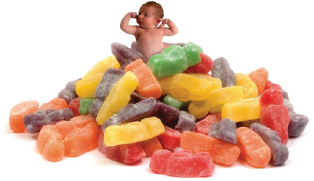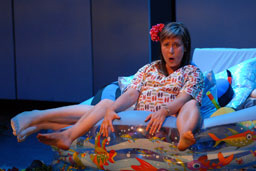|  David Bruce Push! David Bruce Push!
Tête à Tête at Riverside Studios, London 22 June 2006
Music: David Bruce
Words: Anna Reynolds
Musical Direction: Tim Murray
Direction: Bill Bankes-Jones
Design: Tim Meacock
Lighting: Ian Scott
Tara Harrison, Rachel Hynes, Jacqueline Miura, Helen Withers, Louise Mott, Richard Coxon, James Edwards, Mark Richardson
Here is a marvellous little opera, unlike any other; two acts, 75 minutes - its three year gestation culminating in a joyous parturition.
Inititiated by a Genesis Opera Project opportunity, workshopped at Sadlers' Wells, adopted by Tête à Tête and supported by Aldeburgh productions, it is currently mounted to acclamation at Riverside Studios. This staging of six musical births must not escape into oblivion after a few performances in Hammersmith (decent audience, but far from full despite rave reviews) and a short tour to follow in July.
What distinguishes Push! from most small scale opera creations is not the sharing of parts amongst the eight singers, but the lavish orchestra of thirteen multi-instrumentalists which nourished David Bruce's fertile imagination. He writes accessible music, neither simple nor simplistic; a composer to watch and listen out for.
David Bruce studied with Fulkerson, Sackman, Salter, George Benjamin and
Sir Harrison Birtwistle. He is a well equipped composer who has fulfilled previous commissions for Tête à Tête and for Trestle Theatre Company, another company we try never to miss.
The ingenious portable staging and performances by all concerned were beyond criticism, and rather than repeating descriptions to be found in The Times and The Independent I would prefer readers to explore David Bruce and Push! on their respective websites. The Push! website, which is quite uncommonly comprehensive, including the witty libretto and even the full score to download!
There is a sizeable representative excerpt to be heard, and even to be seen on YouTube, about questionable paternity of Cara's coming baby, one of the six to be born on stage during the to be heard on line (recorded at the workshop). The pocket sized programme book is a collectors' piece (I learned yesterday that those for the failed Gubay/Savoy venture now command prices as "collectables"!). Push! will, surely, be captured for TV and DVD?
We have encountered Tête à Tête's experimental opera productions several times, each one enduringly memorable. See our reviews of Family Matters (one story set by six composers, after Beaumarchais' Figaro plays) and Orlando plays mad (exploring whether Vivaldi's operas are ripe for revival?). Next, look out for Odysseus Unbound this coming autumn.
[See also Anna Pickard in The Independent on Sunday for the best review of this little masterpiece.]
Plot summary:
Push! consists of 6 main scenes, each centring on a woman who is in labour. Each scene captures something of the interior life of the woman as she goes through this extraordinary process. Whilst several scenes do have an ‘external' narrative, much of what goes on is viewed through the eyes of the mother. Inevitably, as the intensity of the labour sets in, so the ‘visions' we are presented with become more vivid and extreme.
In the first scene, Nimmy is in labour but is listening on a pocket radio to a football match, as is her boyfriend Ram. Her mind is not where it should be. Nimmy's overbearing parents don't help and it is only resolved when the midwife takes charge of the situation, leading Nimmy onto the imaginary pitch in front of the cheering fans to ‘take the kick'.
 Cara [pictured] is in her birthing pool. One by one, she is confronted by three separate lovers who each ask if they are the father. She angrily sends each of them on their way, before sinking into an underwater world of despair. It is only when she hears the voice of her baby calling her that Cara rises triumphantly to the surface. Cara [pictured] is in her birthing pool. One by one, she is confronted by three separate lovers who each ask if they are the father. She angrily sends each of them on their way, before sinking into an underwater world of despair. It is only when she hears the voice of her baby calling her that Cara rises triumphantly to the surface.
Where the surreal elements only appear later in both Nimmy and Cara, in Maddy we are instantly plunged into a strange and terrifying world. We learn that Maddy is in prison and is going to give the baby up for adoption. Her prison guard Fletcher taunts her and finally reveals her terrible secret. There is no escape for Maddy and the scene ends in despair as the midwife screams a metaphorical ‘catch' to waiting adoptive parents Ben and Angela.
After the interval, Mary is probably the most surreal of all the scenes. She is expecting quintuplets after IVF treatment and is going for a Caesarian. In a somewhat hallucinatory state she talks with her babies about their future life together.
Angela already knows her baby is dead but she shows an incredible dignity in the way she deals with it.
Each of these scenes so far has been interspersed with scenes between the Cleaner and Caretaker , on our maternity ward. In the first scene we see nothing but them cleaning, oblivious to the terrible screams in the rooms around them. The second cleaner scene starts similarly, but then a brief flirtatious conversation develops between the two. Caretaker tries to ask Cleaner out but it is too late, she has already left. In the third scene we see Caretaker at the side of an incubator, tenderly watching a new born baby who is ‘not expected to last the night'. Cleaner enters and sits quietly alongside him. With no words spoken between them, their love for each other is sealed.
In the final scene of the opera, it is Cleaner's turn to give birth. The drama and colour of the previous labours is here stripped away and we are presented with a raw picture of an ‘ordinary woman' going through one of life's most extraordinary processes. Instrumentation
Flute dbl piccolo, Tenor and descant recorders, clarinet mouthpiece
Clarinet in Bb, dbl Eb cl., Bass cl, clarinet mouthpiece, descant recorder
Bassoon , dbl descant recorder, clarinet mouthpiece
Trumpet in Bb, dbl clarinet mouthpiece (straight, harmon and plunger mutes)
Horn in F (straight mute), dbl clarinet mouthpiece and swanee whistle Bass trombone, (straight, harmon and plunger mutes) Accordion
Percussion
Piano dbl harpsichord and electronic organ
2 Violins Cello Double Bass with C extension
5 clarinet mouthpieces are needed for the final scene.
Other requirements
Tape - The Nimmy scene uses a sample of a real heartbeat at two places. This can be operated by either the percussionist or a technician.
2 Megaphones – for the builders in Mary
Microphone and amplifier for the Commentator at the start of the opera.
|



